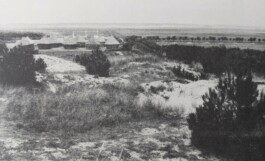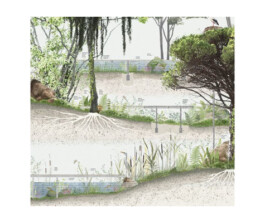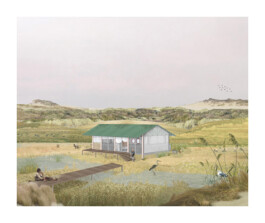UN - Urban Nature
Benoit Burquel, Nadia Casabella, Axel Fisher, François Vliebergh
GHOSTS
Since last year, the design unit is committed to exploring the European rural territories (within the Erasmus+ program NeRu 2022-25, newruralities.eu), and the recent trends that since the COVID-19 pandemic have shaken them. Indeed, the lockdown mainstreamed online working while exacerbating the longing for nature and a sense of belonging. People flocked to the countryside in search of the rural landscapes and the self-absorbed communities they had seen in the movies or remembered vaguely from their childhood. They discovered instead a new rurality, extremely diverse yet recognisable in its big traits: an aging population living in isolation and lacking essential services, a dying economy being humbly reanimated by the growing dependence of cities upon the countryside (for energy, food, raw materials, cheap logistics…), a massive abandonment of the built fabric leading to plummeting land prizes, yet a solid heritage in the form of buildings and anthropized landscapes.
Our approach to this new rurality, or new ‘ruralities’ (if we are to underline their diversity), wishes to be above all exploratory. It starts from the hypothesis that these territories are traversed by a pre-modern, pre-industrial layer that persists in the form of ghosts: the vestiges and signs of past ways of life still charged in the present. As humans reshape the landscape, we forget what was there before. Ecologists call this ignoring the “shifting baseline syndrome.” Our newly shaped and ruined landscapes become the new reality. Sometimes development happened so abruptly that many pre-industrial traditions still exist though. In that sense, ghosts point to our forgetting, showing us how living landscapes are imbued with earlier tracks and traces, and can serve as a source of inspiration for its actualisation.
Our study area was located at the interface between the North Sea and the Polders, stretching over 10-15 kilometres inland and running parallel to the coastline shared by Belgium and the Netherlands, on an area generally known as the Zwin region, the name of the sea inlet that once gave sea access to Bruges. On the shore, the dunes, the towns of Knokke-Heist and Breskens, interspersed among other beach resorts, some bunkers, and the port of Zeebrugge, merged last year with that of Antwerp. Inland, the area is characterized by its flat (minimal height differences that do not exceed 4-5m) and rural character, crossed by a network of ditches, waterways, and canals, which, together with the sluices and dykes, serve to protect the coastal polders from being swamped. Built structures like houses and barns punctuate the landscape.
UN - Urban Nature
Benoit Burquel, Nadia Casabella, Axel Fisher, François Vliebergh

GHOSTS
Since last year, the design unit is committed to exploring the European rural territories (within the Erasmus+ program NeRu 2022-25, newruralities.eu), and the recent trends that since the COVID-19 pandemic have shaken them. Indeed, the lockdown mainstreamed online working while exacerbating the longing for nature and a sense of belonging. People flocked to the countryside in search of the rural landscapes and the self-absorbed communities they had seen in the movies or remembered vaguely from their childhood. They discovered instead a new rurality, extremely diverse yet recognisable in its big traits: an aging population living in isolation and lacking essential services, a dying economy being humbly reanimated by the growing dependence of cities upon the countryside (for energy, food, raw materials, cheap logistics…), a massive abandonment of the built fabric leading to plummeting land prizes, yet a solid heritage in the form of buildings and anthropized landscapes.
Our approach to this new rurality, or new ‘ruralities’ (if we are to underline their diversity), wishes to be above all exploratory. It starts from the hypothesis that these territories are traversed by a pre-modern, pre-industrial layer that persists in the form of ghosts: the vestiges and signs of past ways of life still charged in the present. As humans reshape the landscape, we forget what was there before. Ecologists call this ignoring the “shifting baseline syndrome.” Our newly shaped and ruined landscapes become the new reality. Sometimes development happened so abruptly that many pre-industrial traditions still exist though. In that sense, ghosts point to our forgetting, showing us how living landscapes are imbued with earlier tracks and traces, and can serve as a source of inspiration for its actualisation.
Our study area was located at the interface between the North Sea and the Polders, stretching over 10-15 kilometres inland and running parallel to the coastline shared by Belgium and the Netherlands, on an area generally known as the Zwin region, the name of the sea inlet that once gave sea access to Bruges. On the shore, the dunes, the towns of Knokke-Heist and Breskens, interspersed among other beach resorts, some bunkers, and the port of Zeebrugge, merged last year with that of Antwerp. Inland, the area is characterized by its flat (minimal height differences that do not exceed 4-5m) and rural character, crossed by a network of ditches, waterways, and canals, which, together with the sluices and dykes, serve to protect the coastal polders from being swamped. Built structures like houses and barns punctuate the landscape.



